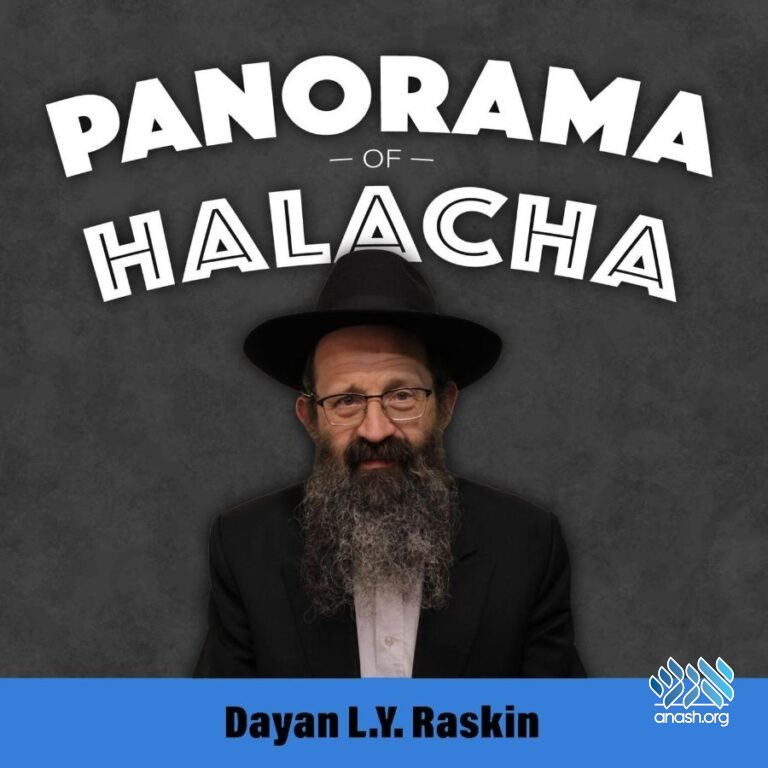Anash.org feature: Dayan Levi Yitzchok Raskin, Rov of Anash in London, explores interesting Torah questions and halachic dilemmas including making kiddush before Shachris, stopping for every kedusha, switching directions during Shmoneh Esrei, and davening for a non-Jew.
The following issues are discussed by Rabbi Raskin in this week’s episode:
- When reciting the brocho of HaGomeil, those present say Amein and bless the person – that Hashem should continue to bestow His kindness upon him. Should the first person acknowledge the community’s blessing with saying Amein?[1]
- Why is it the custom in many Shuls, that a rug is placed for the Kohanim to stand upon whilst bestowing their blessing?[2]
- One sitting and learning in a side room of a Shul and hears Kedusha being recited in the main Shul – is he obliged to interrupt his learning to join in Kedusha?[3]
- One who needs to eat on Shabbos morning before Shacharis, must he first make kiddush?[4]
- When praying for a non-Jew we use the father’s name. What if the biological father is a Jew?[5]
- I’m standing Shmoine Esrei and I realize that I’m facing the wrong direction. What should I do now?[6]
- Follow up from last week: Some of the minyan are in an adjoining room, do they have to ‘visible’ to all of those in the larger room?[7]
- Before the Chuppah, what is first: dressing the Chosson or the Badeken of the Kalloh?[8]
- I daven in a wide but narrow Shul. This creates a situation of walking in front of one who is davening Shmoine Esrei. Any solution?[9]
- A certain chocolate cake retains liquid syrup inside the cake. May this cake be warmed up on Shabbos?[10]
To listen to Panorama of Halacha on a podcast, click here.
- [1] כן הורה הבן איש חי (עקב ס”א).
- [2] פסקי תשובות סי’ קכח אות לא, בשם הרב מבוטשאטש. להעיר שב-770 לא נהגו, כי אם בשנים האחרונות, שאז בנו במה במזרח לכ”ק אדמו”ר זי”ע [תחלה רק לתשרי ואח”כ לכל השנה], אז היה הרבי יורד אל הריצפה וכהנים רבים התלכדו על הבמה.
- הערה: הכהנים עומדים עם אחוריהם לארון הקודש, כי הם מוסרים ברכת השי”ת לכלל ישראל. עד”ז, הכהן המדליק את המנורה עומד כשאחוריו לקה”ק (רשימת המנורה ע’ נ). שי”ל שמשפיע אור מקה”ק אל המנורה, ומשם לכל העולם. להעיר שבתפלה אסור לעמוד במקום גבוה (שוע”ר סי’ צ ס”א). וע”פ הנ”ל מובן, כי הכהן מעניק ברכת השי”ת לקהל.
- [3] ראה שוע”ר סי’ נה סכ”ב: “יכול לענות עמהם”. שלחן שלמה פ”ט ס”ו.
- [4] בביה”ל ר”ס רפט פשיטא לי’ שצריך לקדש. וראה פסקי תשובות שם סק”ח שרבו המקילים. וכן הבאנו בקצש”ע החדש סי’ ח הע’ ב.
- [5] ראה רמ”א סי’ קלט ס”ג; נתיבים בשדה השליחות ח”ב ע’ 70.
- [6] בשוע”ר סי’ צד ס”ג כתב שלא יעשה כלום. ואילו המשנ”ב שם סק”י סבור שיעקם פניו.
- [7] לפי שוע”ר סי’ קצה ס”א די ברואים מקצתן. ושם ס”ג מוסיף שאפילו אם אין הקבוצות רואות זא”ז, הרי המזמן מצרף אותם.
- [8] ראה ימי מלך פ”י.
- [9] ראה שוע”ר סי’ קב ס”ד.
- [10]


The question was “One who needs to eat on Shabbos morning before Shacharis, must he first make kiddush?” Yet the caption is “CAN I MAKE KIDDUSH WHEN EATING BEFORE SHACHRIS?” – That’s two different questions!